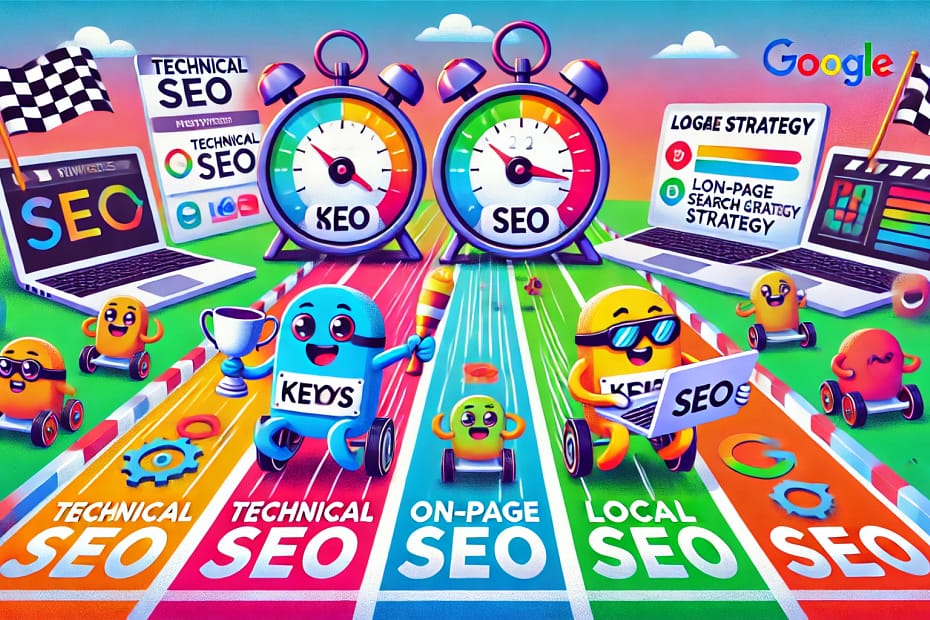
8 tips to Compare Your Site’s SEO with Competitors
Compare Your Site’s SEO with Competitors with 8 tips!
To succeed in today’s digital landscape, a robust SEO strategy is essential, and understanding where you stand in relation to your competitors is crucial. Comparing your SEO performance with competitors can highlight areas for improvement, reveal untapped opportunities, and provide insights into the strategies driving their success. In this guide, we’ll walk through eight key areas of comparison, using real examples to illustrate each point.
1. Keyword Performance
Your Site: Start by reviewing the keywords your site is ranking for. Use tools like Google Search Console to identify these keywords, along with their search volumes and positions. Suppose you have an e-commerce site that sells eco-friendly products. You might rank for keywords like “sustainable shopping bags” or “recycled paper notebooks.” Analyze how much traffic these keywords bring in and where your site ranks (e.g., position 8 on Google).
Competitors: Examine the keyword strategy of your top competitors. Use tools like SEMrush or Ahrefs to research which keywords are driving the most traffic to their sites. For instance, if a competitor ranks higher for “organic cotton tote bags,” assess why—perhaps their content is more optimized, or they have better backlinks. Also, look at long-tail keywords (e.g., “best organic cotton tote bags for grocery shopping”) that might offer less competition but high conversion potential.
Example: If you find your competitor ranks higher for “sustainable fashion accessories,” consider optimizing your product pages for related terms or creating a dedicated blog post that targets these keywords to close the gap.
2. Backlink Profile
Your Site: Backlinks are one of the most important factors in search engine rankings. Tools like Moz or Ahrefs allow you to see how many backlinks your site has and the quality of the referring domains. For example, your eco-friendly product site might have backlinks from small sustainability blogs or eco-conscious forums. Check if these backlinks come from high-authority domains.
Competitors: Next, analyze your competitors’ backlink profiles. A competitor might have a backlink from a high-authority site like National Geographic or a popular eco-blog, boosting their SEO significantly. Investigate if you can replicate some of these backlinks by pitching your site to similar publications or writing guest blog posts.
Example: If a competitor has many backlinks from influencer collaborations, you could consider launching a similar influencer marketing campaign to generate high-quality backlinks.
3. Content Strategy
Your Site: Content is king, and having well-structured, informative content is essential. Analyze your blog and product page structure—do you use clear, engaging headlines, proper formatting, and appropriate keyword density? Check if your content is updated regularly. For example, your eco-friendly blog might cover topics like “How to Start a Zero-Waste Lifestyle,” but perhaps it’s time to refresh the article with new statistics or trends.
Competitors: Look at how competitors structure their content. Are their articles more in-depth or up-to-date? Do they cover topics you’ve missed? For example, a competitor may have interactive infographics or video content on their site, providing a richer user experience.
Example: If you notice a competitor’s article titled “Top 10 Eco-Friendly Products for 2024” that ranks higher than your similar post from 2022, you might want to update your content with current information or add new media formats like videos.
4. Technical SEO
Your Site: Technical SEO involves optimizing your site for fast loading times, mobile-friendliness, and proper indexing. Use tools like Google PageSpeed Insights or GTmetrix to analyze your site’s load times. If your eco-friendly shop takes 5 seconds to load, but competitors’ sites load in under 3 seconds, you could be losing traffic.
Check mobile-friendliness using Google’s Mobile-Friendly Test. Ensure your site has a clean structure, proper schema markup, and SSL security.
Competitors: Look at how well your competitors are optimized technically. If they have better mobile experiences or faster load times, they might rank higher simply due to better technical SEO. For example, a competitor’s site might score 95/100 on PageSpeed Insights, while yours scores 75/100.
Example: If competitors load faster, consider reducing image sizes, implementing lazy loading, or using a Content Delivery Network (CDN) to improve your site’s performance.
5. On-Page SEO
Your Site: On-page SEO involves optimizing elements like meta descriptions, title tags, headers, and internal linking. For instance, ensure your product pages have engaging title tags, such as “Buy Eco-Friendly Tote Bags | Sustainable Shopping.” Meta descriptions should be compelling and keyword-rich but not stuffed.
Competitors: Check how your competitors use these elements. Do their meta descriptions or title tags seem more engaging? For instance, if a competitor’s product page has a title like “Top Rated Organic Cotton Bags,” it might attract more clicks than a generic title like “Tote Bags for Sale.”
Example: If a competitor is using more optimized headers (H1, H2s), you could revisit your content structure to ensure your headers are keyword-rich and helpful for both users and search engines.
6. Social Signals & Engagement
Your Site: Search engines consider social signals, such as shares, likes, and comments, as indicators of content value. Look at how much engagement your content gets on platforms like Facebook, Instagram, or LinkedIn. If your blog posts about sustainable living get shared often, that’s a positive sign.
Competitors: Compare your social media activity with competitors. A rival might have higher engagement because they are more active on Pinterest, which drives a lot of traffic in the eco-friendly niche. Analyze what types of content get the most traction on social media.
Example: If your competitor’s posts get significantly more shares or comments, it could indicate they’re more effectively reaching your shared audience. Consider ramping up your social strategy with giveaways or collaborations.
7. Local SEO (if applicable)
Your Site: If your business targets local customers, optimizing for local SEO is crucial. Start by ensuring your Google My Business listing is up-to-date and optimized with correct contact details, opening hours, and relevant images. Additionally, focus on local content such as blog posts targeting local sustainability events.
Competitors: Look at how competitors rank in local search results. Do they appear more often in the “local pack” or Google Maps? Are they optimizing better for keywords that include your city or region, like “eco-friendly products in Los Angeles”?
Example: If a competitor ranks higher for “best zero-waste stores in San Francisco,” consider adding more localized content and getting more local backlinks (e.g., from local eco-groups).
8. Page Authority and Domain Authority
Your Site: Domain Authority (DA) and Page Authority (PA) are metrics that help gauge the overall strength of your site and individual pages. A higher DA means your site is more likely to rank well on search engines. Use Moz or Ahrefs to check your current scores.
Competitors: Compare these scores with competitors. If their DA is significantly higher, this means their site is generally seen as more authoritative by search engines, possibly due to higher-quality backlinks, better content, or longer site history.
Example: If your site has a DA of 30 but a competitor has a DA of 50, focus on building high-quality backlinks and improving your content to increase your DA over time.
Tools for SEO Comparison
- Google Analytics & Google Search Console: Track your own traffic and keyword performance.
- Ahrefs / SEMrush: Great for analyzing competitors’ keywords, backlinks, and content strategies.
- PageSpeed Insights: Measures your site’s technical performance, including mobile and desktop load times.
Final Thoughts
Comparing your site’s SEO performance with competitors is a powerful way to identify gaps and opportunities for growth. By carefully analyzing keywords, backlinks, content, and technical SEO, you can refine your strategy and improve your rankings. Remember, SEO is an ongoing process, and staying informed about your competitors’ tactics will help you stay ahead of the curve.
Read more
SEO categories and subcategories
🚀🏆 Keep crushing that SEO game!
Source OpenAI’s ChatGPT Language Model and DALLE – Images Picsart

Invest in your future & learn
Learn affiliate marketing & build your own website.
Heads up! Make sure you sign up using my referral link to get access to my personal coaching and all features.
👉 Sign Up




